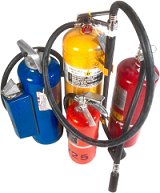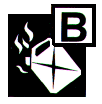 Ahhh, the bright red fire extinguisher, you can hardly go throughout a day without hardly seeing one; but how much do you know about them, how will you REACT, and why does everyone want you to PASS the extinguisher (don’t they realize you got it)?
Ahhh, the bright red fire extinguisher, you can hardly go throughout a day without hardly seeing one; but how much do you know about them, how will you REACT, and why does everyone want you to PASS the extinguisher (don’t they realize you got it)?
The 5 Classes & Rating of Extinguishers:
There are 5 general classifications of materials that extinguishers are created to combat which combined with its ability to combat that type of fire, an extinguisher is given a rating. While many extinguishers used to use a letter &/or color to show which type of fire it was meant for, many countries are now opting for a pictorial style. If you happen to see a picture with a red line across it &/or they are *blacked out – it is not to be utilized for that type of fire.
*Shown below in Blue is the US style, while the black ones depict the UK standard. (Many thanks to the UK Fire Safe org for their version of the pictures & I recommend if you live or are travelling across the pond, you check out their great chart for their specific “colour” codes)

 Class A: Ordinary combustibles
Class A: Ordinary combustibles
- wood, cloth, paper, plastic
- Old Style: Triangle with the letter “A” – If colored, the triangle should be green.
- 1A, 2A, 3A, 4A, 6A, 10A, 20A, 30A, 40A: 1A is the equivalent fire stopping ability of pouring 5 liters of water on a fire, while 2A would be double that
- gasoline, oil and oil-based paint
- Old Style: Square with the letter “B” – If colored, the square shall be colored red.
- 1B, 2B, 5B, 10B, 20B…, 640B: This signifies the square footage that can be extinguished

 Class C: Energized electrical equipment
Class C: Energized electrical equipment
- wiring, fuse boxes, circuit breaker
- Old Style: Circle with the letter “C” – If colored, the circle should be colored blue.
- There is no specific rating available for this, only that the extinguishing material is non-conductive & displaces Oxygen (no oxygen – no fire)
- Magnesium, lithium, sodium, etc…
- Five-pointed star with the letter “D” – If colored, the star shall be colored yellow.
- There is no rating system for this & these are not meant for home use

 Class K or F: Fire in cooking appliances involving combustible cooking products such as vegetable or animal oils and fats. While these are typically only found in eateries, with the onslaught of commercial grade appliance being introduced into homes, you may want to consider having one installed in your custom range hood.
Class K or F: Fire in cooking appliances involving combustible cooking products such as vegetable or animal oils and fats. While these are typically only found in eateries, with the onslaught of commercial grade appliance being introduced into homes, you may want to consider having one installed in your custom range hood.
REACT (upon discovery of smoke or fire):
- R – Remove persons in immediate danger
- E – Ensure doors are closed (This is to help contain the fire & smoke)
- For homeowners; This means if you exit through the front door, you shut it, you don’t go running in to shut all the doors
- In office buildings, this is one reason why all fire doors must not be left open or blocked
- A – Activate the Building Alarm (assuming there is one)
- C – Call the Fire Department (even if you activated the alarm as they may not have received that call)
- T – Treat all fires as dangerous, even if you think you can knock the fire out & you feel safe doing so, make sure everything else is ongoing in case it doesn’t work
PASS?
No folks, they don’t want you to pass them the extinguisher, it is a simple acronym that stands for; Pull the pin, Aim at the base of the fire, Squeeze the trigger, and Sweep the nozzle or hose from side to side. I can’t recall how many safety classes, etc… I have gone to, but almost every instructor mentions how many times they have talked with people or seen a perfectly good extinguisher rendered inoperable as someone forget the basic steps in the heat of the moment. One other item a few have mentioned is there should be another S at the end, for Stop & evaluate – make sure it doesn’t reignite while you are patting yourself on the back.
Additional Information & Websites:
- OSHA – Classification of Portable Fire Extinguishers
- Fairfax County: Fire Extinguisher Basics & Safety Training Module
- HTRC articles on Fire Safety and Carbon Monoxide




Great posting Sean. I’m frequently amazed by how many people I regularly encounter who don’t have fire extinguishers in their homes, not even in their kitchens. What’s more, it’s not something that even occurs to them. So it’s important that this message be reiterated by as many knowledgeable people, and as frequently, as possible.
insert whistling smillee here…
Thanks John, but I do have to say mea culpa – I left the ones we had in Phoenix with some friends & still have yet to replace them – oops
Of course that does bring up another issue – if you do have them, you need to make sure they are still workable as the charge will drop off on many of them over time (so even if i had kept them – they probably would have had to be replaced) Hmmm, I might have to check the annual maintenance sheet as this should be done when you check the smoke detector batteries
insert whistling smillee here…
Thanks John, but I do have to say mea culpa – I left the ones we had in Phoenix with some friends & still have yet to replace them – oops
Of course that does bring up another issue – if you do have them, you need to make sure they are still workable as the charge will drop off on many of them over time (so even if i had kept them – they probably would have had to be replaced) Hmmm, I might have to check the annual maintenance sheet as this should be done when you check the smoke detector batteries
Great posting Sean. I’m frequently amazed by how many people I regularly encounter who don’t have fire extinguishers in their homes, not even in their kitchens. What’s more, it’s not something that even occurs to them. So it’s important that this message be reiterated by as many knowledgeable people, and as frequently, as possible.
insert whistling smillee here…
Thanks John, but I do have to say mea culpa – I left the ones we had in Phoenix with some friends & still have yet to replace them – oops
Of course that does bring up another issue – if you do have them, you need to make sure they are still workable as the charge will drop off on many of them over time (so even if i had kept them – they probably would have had to be replaced) Hmmm, I might have to check the annual maintenance sheet as this should be done when you check the smoke detector batteries
insert whistling smillee here…
Thanks John, but I do have to say mea culpa - I left the ones we had in Phoenix with some friends & still have yet to replace them – oops
Of course that does bring up another issue – if you do have them, you need to make sure they are still workable as the charge will drop off on many of them over time (so even if i had kept them – they probably would have had to be replaced) Hmmm, I might have to check the annual maintenance sheet as this should be done when you check the smoke detector batteries